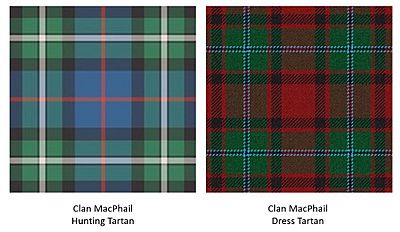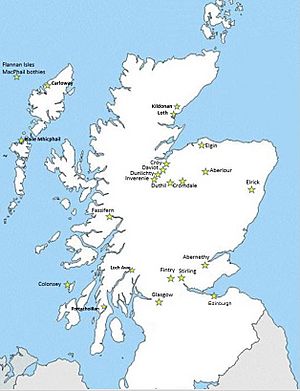Clan MacPhail facts for kids
Quick facts for kids Clan MacPhail |
|||
|---|---|---|---|
| Conchie Dhu or Condochy Doye | |||

Crest: A stag salient
|
|||
| Motto | “Memor Esto” (Be Mindful) | ||
| Profile | |||
| Region | Highland | ||
| District | Inverness | ||
| Plant badge | Red whortleberry, bearberry, | ||
| Animal | Stag | ||
| Pipe music | The MacPhail's Banner (by Allan W.R. McBean) | ||
 |
|||
| Clan MacPhail has no chief, and is an armigerous clan | |||
| Seat | Inverernie | ||
| Last Chief | Paul MacPhail | ||
| Died | early 1900s | ||
|
|||
|
|||
|
|||
Clan MacPhail is a Scottish clan from the Highlands. The name means "Sons of Paul". In Scottish Gaelic, they were known as Conchie Dhu or Condochy Doye. This clan is mostly linked with the large group of clans called the Chattan Confederation.
Contents
History of Clan MacPhail
Where Did Clan MacPhail Come From?
The MacPhails' original Gaelic name was Conchie Dhu or Condochy Doye. They had a strong base at Fassfern until 1291. This place was about 16 kilometers west of Fort William.
Joining the Clan Chattan Federation
The MacPhails were always seen as part of the old Clan Chattan family. They were close to the MacPhersons and MacBeans. These clans, along with others, formed the Clan Chattan Federation. The name Cattanach is still used by families from these clans.
It's believed that the first MacPhails came from a person named Paul Cattanach. The name MacPhail means "Son of Paul". Records from early times mention a "Paul Gow MacPhail". He was called a "good sir," which was a way to address church leaders back then.
Clan MacPhail's Own Story
When the chief of Clan MacKintosh, Angus, married a Clan Chattan heiress in the 1200s, many Chattan families moved. Clan MacPhail also moved to eastern Inverness-shire.
In 1414, a MacPhail named Gillemore M'Phale was part of an important land survey. This survey was about Donald, the Thane of Calder's land at Dunmaglass.
In 1547, a MacPhail named Duncan Makconquhy Dow leased land. He rented half of the towns of Tullich and Elrick. His family kept this lease for many generations.
In 1595, Andrew M'Phail, a minister, and Findla MakPhail, a town official, signed a contract. This contract was between the leaders of Inverness and a man named Robert Waus.
In 1631, another MacPhail got a long lease for land at Invernarnie. This land was near the River Nairn. It also included Duglass and Dullatur near the River Findhorn. MacPhail families lived on these lands until 1773. After that, the lease was not renewed. Many MacPhails then moved south to Argyllshire and became part of city life.
Even so, MacPhail leaders continued to sign Clan Chattan agreements. This showed their important place in the Federation during the 1600s and 1700s.
Some of the Clan MacPhail chiefs included:
- Duncan MakDonequhy Dow MacPhail in 1546
- Paul MacPhail in 1689
- Robert MacPhail in 1721
- Alexander MacPhail in 1743
The MacPhails of Inverernie and the Shaws of Tordarroch buried their family members together. Their burial place was next to the Dunlichty Kirk.
The last direct chief of Clan MacPhail was Paul MacPhail. He passed away in Australia in the early 1900s.
Clan MacPhail Symbols
Clan MacPhail members can wear a crest badge. This badge shows their loyalty to their clan chief. It has the chief's heraldic crest and heraldic motto. These symbols belong only to the chief. People usually wear the badge on a bonnet or on a tartan sash.
MacPhail Families in Other Clans
Some MacPhail families also lived with other large clans.
With Clan MacKintosh
Since the 1400s, many MacPhails lived near Inverernie. This area is close to Loch Moy, which was the home of the MacKintosh chiefs.
In 1490, a Donald MacPhail was a witness to an agreement. This agreement was between the leaders of MacKintosh and Kilravock. He was also a tenant in Dullatur.
A MacPhail, who was a church leader in Croy, wrote a history of the MacKintoshes. This history is known as the Croy Manuscript. Some MacPhails married MacKintoshes. Because of their close ties, they can also wear the Clan MacKintosh tartan.
With Clan Cameron
Some MacPhails stayed in the west and did not move with Clan MacKintosh. They later joined Clan Cameron. These MacPhails lived at Fassfern on Loch Eil. Some of them were known for cattle raiding with Ewen Cameron in 1547.
Different spellings of the name found with Clan Cameron include MacKail and MacVail. These MacPhails can also wear the Clan Cameron tartan. They are considered a "sept" (a family group) of that clan.
With Clan Campbell
Some MacPhails later moved to Argyll and joined Clan Campbell. Records show MacPhails in Campbell lands in the 1600s and 1700s. For example, John MacPhail lived in Auchauaich around 1691. MacPhails were often found in a narrow valley between Loch Awe and Loch Etive. Some of them became ship builders.
With Clan Donald
MacPhail families were also found across the West Highlands and Islands. This includes places like Glengarry, Glencoe, North Uist, Islay, and Kintyre.
With Clan Grant
Johannes McFaill was a church member in Duthil. Gillepatrik McFale lived in Glenurquhart in 1545. Duncan McFaill was a reader (someone who reads church services) at Cromdale in 1584. Other spellings of the name were seen later in places like Invera’en and Abernethy.
With Clan Macleod of Lewis
In the late 1700s, the MacLeods of Lewis believed their MacPhails came from Páll, son of Bálki. He was a lord in the Hebrides in the 1200s. He was an ally of Olaf the Black, a king of Mann and the Isles. There's a village on the northern tip of the island called Baile Mhicphail (Macphail's village).
The Flannan Isles are a group of sea rocks off the Isle of Lewis. They were seen as a holy place and had many seabirds. On one island, there are two stone houses called the Clan MacPhail bothies. These are thought to be old monk cells from a small early Celtic church.
Donald MacDonald wrote a book about the MacPhails of Lewis. He said they were used as "wardens" by the MacLeods. They were placed along the west coast to stop other clans from raiding.
A Different MacPhail Line?
With Clan Mackay
A family group of Clan Mackay called Polson is also known as Siol Phail. They are believed to be related to Neil, son of Neil, son of Donald Mackay, 5th of Strathnaver. This Neil Neilson Mackay fought against his own relatives in 1433. But the Polsons later rejoined their Strathnaver kin.
In the late 1400s and early 1500s, Sir John Polson helped Iye Roy Mackay, 10th of Strathnaver.
At the Battle of Torran Du in 1517, the Polsons supported Clan Mackay. In a list of men able to fight in 1745, many Polsons appeared. However, by 1906, many of them had started using the surname MacPhail or Mackay.
Changes to the Name
Many Highland families dropped the "Mac" or "Mc" from their names. This happened when they moved to cities like Glasgow and Edinburgh. They did this to fit in better, especially after the Jacobite Rebellion. MacPhail sometimes became Phail or even Paul.
The surnames Paul and Paull were also very old names. They were found in different areas like Daviot and Stirlingshire in the 1600s. Not all Scottish Paul families came from Gaelic or Highland clans. Some Pauls in Glasgow might have come from Flanders.
Many MacPhail families moved to America and Australia. This happened during the Highland Clearances. Their records can be hard to find now.
Where MacPhails Are Today
Today, MacPhails can usually trace their family history to four main groups in Scotland:
- Those with the Clan Chattan Federation, who had their own chief and were allied with Clan MacKintosh.
- Those who joined Clan Cameron from the 1500s onwards.
- Those who joined Clan Campbell and others around Argyll.
- Those with Clan Mackay in the north of Scotland.
In Folklore
The Mermaid of Corrivrekin
The poet John Leyden loved old stories. He wrote a poem called "The mermaid." It was based on an old Gaelic song about MacPhail of Colonsay and the Mermaid of Corrivrekin. The story says a mermaid took MacPhail away. They lived in a cave under the sea and had five children. But MacPhail eventually missed land and escaped.
The Ballad of Mull
A stone monument near Loch Spelve honors Dugald MacPhail (1819-1887). He was a poet who wrote "Ant-Muileach" (The Isle of Mull). This song became the island's anthem. These MacPhails were known for moving cattle for hundreds of years in that area.
Notable Descendants
Other Names from MacPhail
Irish Names
Records of McFall, McFaul, and McPhails are found in Ulster. They are especially common around Antrim and Derry. These names seem to have appeared during the British Plantation period. For example, Sarah Jane, daughter of William McFaul, was christened in Ballymena in 1824.
Other related names include MacPhóil, MacPóil, MacPaul, MacVail, Vail, Paulson, Polson, and Powlson.



